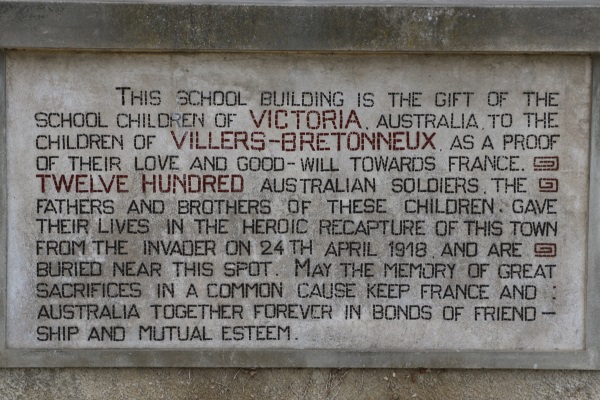Anzac Day 2018 marked the centenary of the Second Battle of Villers-Bretonneux when Australians recaptured this small French village from the Germans, creating a unique and enduring bond.
The following adderss was given by Charles Rees at the Dawn Service at Dimboola on Anzac Day 2018.
Villiers-Bretonneux is a small town on the Roman Road 20 km east of the city of Amiens in northern France, and is very grateful to the contribution made by Australians during World War One.
Located on a plateaux above the River Somme valley on the Western Front, the town was occupied by German troops during the March Offensive of 1918.
The Germans were repelled by British troops, but these inexperienced young soldiers were soon outnumbered by the invading German Army. Allied supreme commander Marshal Ferdinand Foch ordered the town to be retaken and the Australian 13th and 15th Brigades were sent in on April 24, and they met the British troops on the road with the fleeing residents of Villers-Bretonneux.
In a surprise night-time operation, the Germans were routed by the next morning, April 25 / Anzac Day, in a battle of brutal wild bloody hand to hand combat and without artillery cover. The casualties on both sides were very high, with extensive damage to the town s buildings.
British General Rawlinson described the Australian s achievement as tenacity and valour. Their success was to secure the key railway centre, the city of Amiens. John Monash (later Sir) said the recapture of Villers-Bretonneux was a symbolic turning point of the War.
There remains a 100 year bond between Villiers-Bretonneux and Australia. The main street from the town square is Rue la Melbourne and the school is on Rue du Victoria. A cafe is named Cafe de Kangarue. At the town hall the Australian and French flags are displayed on each side of the entrance, along with painted kangaroos.
After the War the badly damaged school was rebuilt, aided by the Victorian Education Department s patriotic fund, being donations from students and staff. A plaque reads This school building is the gift of the school children of Victoria, Australia, to the children of Villiers-Bretonneux as proof of their love and good-will towards France.
In 2009 French school children raised and donated money to aid the rebuilding of a school following the Victorian Black Saturday bushfires.
A wonderful memory of my visit to Villiers-Bretonneux in 2007 is a gift of a small soft pink toy pig from a group of school children, presented to my son John and me, when they learnt that grand-father Rees was there during World War 1.
There is a sign (pictured above) at the school that reads DO NOT FORGET AUSTRALIA.
In the Australia-Franco hall next to the school are carved figures of Australian flora and fauna atop timber columns.
The Western Front Australian War Memorial is located on the hilltop of the Villiers-Bretonneux WW1 Cemetery, overlooking the River Somme valley. Ten thousand Australian sons are honoured there; recorded on the walls, along with the battles Australians fought in. Unveiled in 1938, it was designed by West Australia architect/soldier Lieutenant-General Sir Talbot Hobbs.
100 years since the battle and 80 years after the unveiling, the worth of Australian General Sir John Monash in WW1 is recognised with the opening of the Sir John Monash Centre, by Prime Minister Malcolm Turnbull on April 24 this year.
The Unknown Soldier who lies at rest in the Australian War Memorial in Canberra, was exhumed from the Adelaide Cemetery, on the outskirts of Villiers-Bretonneux in 1973.
The Victorian town of Robinvale has a civic-sister connection with Villiers-Bretonneux.

Above - a inscription on the front of the Villers-Bretonneux school commemorating the connection between the school and Australia.
|






